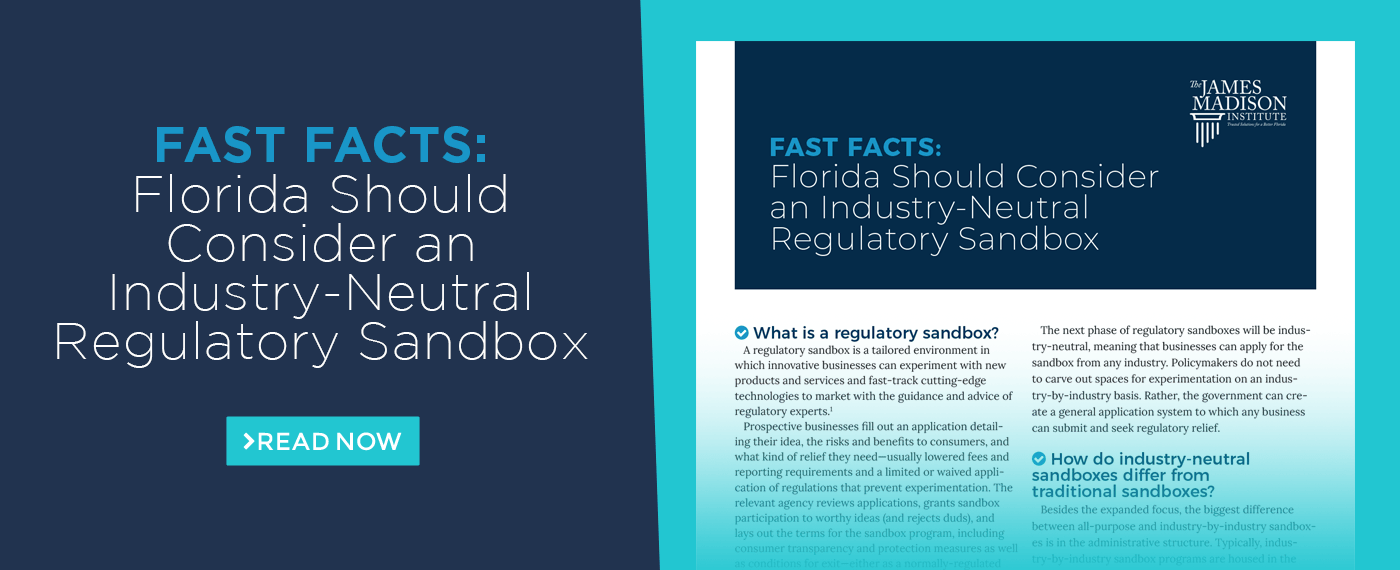Click here to read the full PDF
What is a regulatory sandbox?
A regulatory sandbox is a tailored environment in which innovative businesses can experiment with new products and services and fast-track cutting-edge technologies to market with the guidance and advice of regulatory experts.[1]
Prospective businesses fill out an application detailing their idea, the risks and benefits to consumers, and what kind of relief they need—usually lowered fees and reporting requirements and a limited or waived application of regulations that prevent experimentation. The relevant agency reviews applications, grants sandbox participation to worthy ideas (and rejects duds), and lays out the terms for the sandbox program, including consumer transparency and protection measures as well as conditions for exit—either as a normally-regulated entity, or a “failure” that closes shop.
Typically, regulatory sandboxes are defined for a specific industry, but that is changing. Florida has already passed a regulatory sandbox program for financial technology firms,[2] and other states have followed our lead or experimented with other kinds of regulatory sandboxes.[3]
What are the national trends?
Regulatory sandboxes have proven popular, with dozens of states passing or considering this kind of fast-track program over the past five years.[4] Fintech sandboxes are the most common option, but states have also created sandboxes for innovative insurance and legal products.
The next phase of regulatory sandboxes will be industry-neutral, meaning that businesses can apply for the sandbox from any industry. Policymakers do not need to carve out spaces for experimentation on an industry-by-industry basis. Rather, the government can create a general application system to which any business can submit and seek regulatory relief.
How do industry-neutral sandboxes differ from traditional sandboxes?
Besides the expanded focus, the biggest difference between all-purpose and industry-by-industry sandboxes is in the administrative structure. Typically, industry-by-industry sandbox programs are housed in the agency that would administer the regulations for which the participant receives relief. The office not only runs the program, but it also receives and evaluates applications for participation. In Florida, for instance, the Office of Financial Regulation operates the fintech sandbox, since they have best knowledge of the rules for which applicants need an exemption.
With an industry-neutral sandbox, there is no obvious “landing place” to receive and evaluate applications. Applicants could be seeking relief from any number of government agencies. Therefore, many industry-neutral sandbox proposals and programs create a new body to evaluate applications. This body will determine which agency should be involved for relief, consult with that agency for input, and determine which applications get approved as well as any conditions for that applicant. The relevant agency will then administer the program in collaboration with the application agency and any other groups the legislature may designate.
How can Florida take the lead on industry-neutral sandboxes?
Utah is the first state to have passed an industry-neutral regulatory sandbox.[5] Other states, such as Tennessee, are now following the lead and moving ahead.[6]
In addition to creating a new agency to evaluate applications and designate the appropriate agency for each worthy applicant, these proposals create rules to allow the greatest possible space for innovation. It would be an ironic failure if the sandbox program merely served as an institution that only granted access to insiders and kept out promising competition.[7] This is why states are including transparency and non-discrimination measures. Examples include requiring that applications and justifications be posted for public viewing or instructing the evaluation body to weigh the fact that a competitor was granted sandbox entrance as a strong factor in favor of approval.
Florida should build on these examples and consider forming its own industry-neutral sandbox. Our state has been fortunate enough to attract many cutting-edge technology startups in the past year, particularly in Miami, Jacksonville, and Tampa. Some ventures in this vein do not fit neatly into established regulatory categories. Distributed autonomous organizations, or DAOs, straddle the lines between finance, investing, law, and charity, for instance.[8] A carefully designed industry-neutral sandbox can create just the right space for innovation to allow DAOs and all manners of innovative ideas to take off and flourish in our state.
[1] This brief is based on: Andrea O’Sullivan, “Expanding Regulatory Sandboxes to Fast-Track Innovation,” James Madison Institute, January 1, 2027, https://jamesmadison.org/wp-content/uploads/2021/01/Regulatory_Sandbox_1.27.21.pdf.
[2] “Financial Technology Sandbox Innovator,” Florida Office of Financial Regulation, accessed December 21, 2021, https://flofr.gov/sitePages/FinancialTechnologySandbox.htm.
[3] For example, states have implemented sandboxes for insurance products and legal services, as well as an industry-neutral sandbox in Utah. See: “Insurance Regulatory Sandbox; Innovation Waiver Regulation,” State of Vermont Department of Financial Regulation, December 9, 2019,
https://dfr.vermont.gov/reg-bul-ord/insurance-regulatory-sandbox-innovation-waiver-regulation; “The Office of Legal Services Innovation,” Utah Supreme Court, accessed December 21, 2021,https://sandbox.utcourts.gov/; Andrea O’Sullivan, “Utah Eases Up on the Bureaucracy with Nation’s First General Regulatory Sandbox,” Reason, March 16, 2021, https://reason.com/2021/03/16/utah-eases-up-on-the-bureaucracy-with-nations-first-general-regulatory-sandbox/.
[4] “Key Data from Regulatory Sandboxes across the Globe,” World Bank, November 1, 2020, https://www.worldbank.org/en/topic/fintech/brief/key-data-from-regulatory-sandboxes-across-the-globe.
[5] Rep. A. Cory Maloy, H.B. 217 Regulatory Sandbox Program Amendments, Utah State Legislature, 2021 General Session, https://le.utah.gov/~2021/bills/static/HB0217.html.
[6] Sen. John Stevens, SB899 “Innovation FastTrack Act,” Tennessee State Legislature, 2021, https://trackbill.com/bill/tennessee-house-bill-510-commerce-and-insurance-dept-of-as-introduced-enacts-the-innovation-fasttrack-act-amends-tca-title-4-title-56-chapter-1-title-62-and-title-63/2147061/.
[7] Brian Knight and Trace Mitchell, “The Sandbox Paradox: Balancing the Need to Facilitate Innovation with the Risk of Regulatory Privilege,” Mercatus Center at George Mason University, March 26, 2020, https://www.mercatus.org/publications/financial-markets/sandbox-paradox-balancing-need-facilitate-innovation-risk-regulatory.
[8] Andrea O’Sullivan, “Reforming Florida Law So DAOs Are Not DOA,” The Journal of the James Madison Institute, Fall 2021, https://jamesmadison.org/wp-content/uploads/2021/10/Journal_13_Fall2021.pdf.












